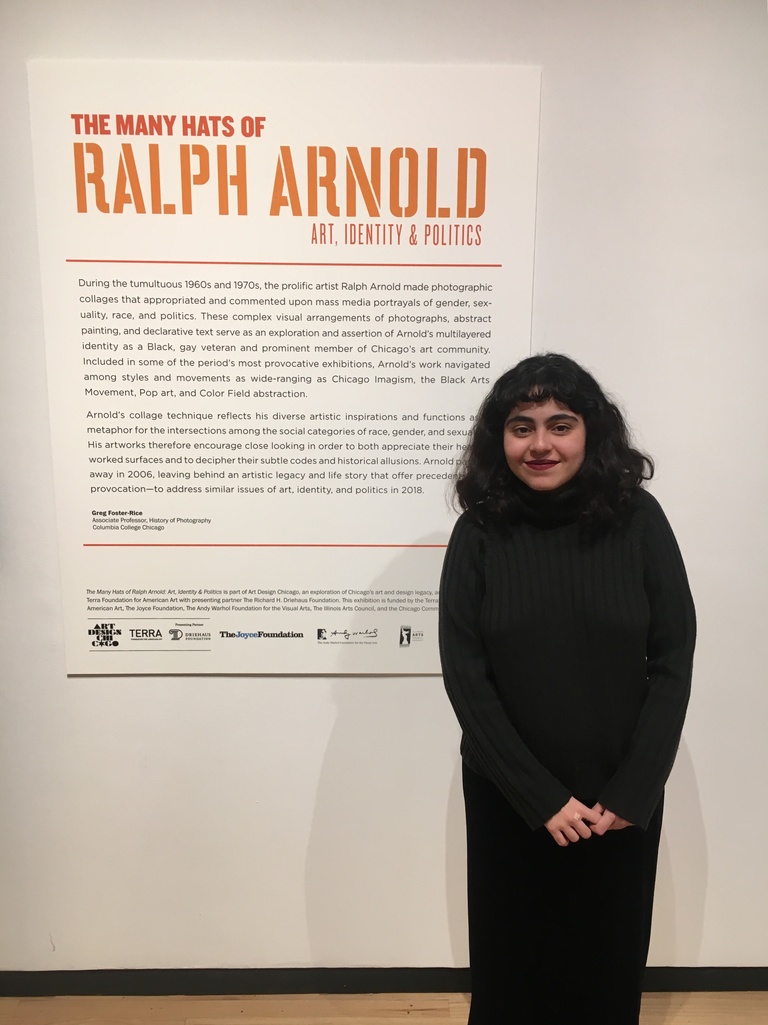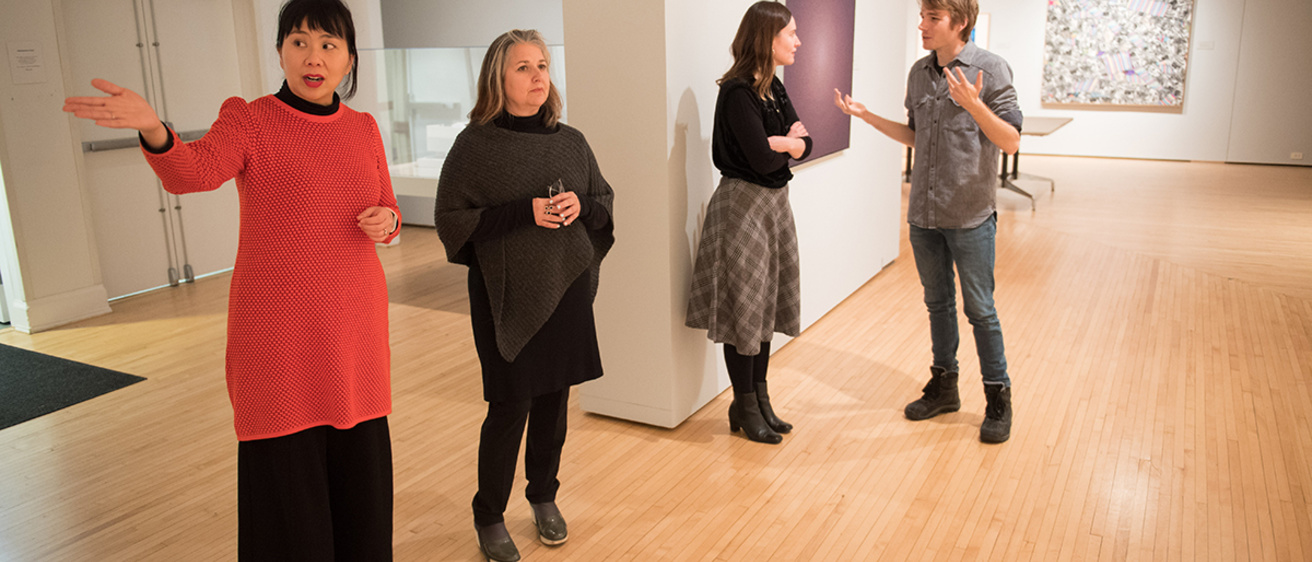Dalina Perdomo-Álvarez was working toward her MA in film studies from the University of Iowa but she wasn’t exactly sure what she wanted to do with her degree. While exploring possibilities, she took a museum studies course through the School of Art and Art History.
“I thought that film studies people couldn’t really do museum stuff because that was for art history students,” says Perdomo-Álvarez, who is from Puerto Rico and received her degree in May 2018. “But I learned there are so many things you can do in a museum, and you don’t have to be an art history major to do it.”
“We’re teaching research skills and critical thinking skills. We’re teaching students how to be part of a team and part of a professional workplace. We’re helping them make connections to the professional art world.”
—Lauren Lessing, director of the UI Stanley Museum of Art
That class launched Perdomo-Álvarez on a new trajectory that included working as a gallery attendant at the UI Stanley Museum of Art and becoming a research assistant for a project related to the history of intermedia led by Joyce Tsai, clinical associate professor in the College of Education and a curator at the museum. Perdomo-Álvarez says these experiences are the reason she landed her current positions as a curatorial fellow for diversity in the arts at the Museum of Contemporary Photography in Chicago and as a distribution assistant at Video Data Bank at the School of the Art Institute of Chicago.
“When I was applying for the museum job, they were targeting people who had their master’s in art history,” Perdomo-Álvarez says. “I was able to talk about my work at the museum and my research work with a curator. And at the Video Data Bank, I could tell them I’ve worked directly with video art and talk about artists like Hans Breder and Ana Mendieta. It’s not common to have someone who has worked on stuff like that straight out of school.”
The opportunities Perdomo-Álvarez found through the Stanley Museum of Art are not unusual at the UI. This past year, 15 students from various disciplines across campus worked with museum staff to research items in the collection, learn about the scientific methods to analyze artworks and the materials that comprise them, assist in assessing the condition of the art, give tours of the museum, and contribute to outreach.
“These are experiences you don’t get in a classroom,” says Tsai. “We’re really at the leading edge of thinking very seriously about our role as an art museum within a research university. We want our students to be producers of research and producers of knowledge, and not just a one-way dissemination of it.”
Lauren Lessing, director of the Stanley Museum of Art, says students learn a range of skills when they engage with the museum, whether through the curriculum or professional work.
“We’re teaching research skills and critical thinking skills,” Lessing says. “We’re teaching students how to be part of a team and part of a professional workplace. We’re helping them make connections to the professional art world.”
Gallery attendants, which Tsai calls the public face of the museum, may be the most visible students working there. Among other duties, gallery attendants answer questions from visitors, lead tours, and work with security as the first line of defense in making sure the artwork is safe.
“They learn to be stewards of a collection,” Lessing says. “They learn communication skills and to interact with the public. It requires leadership and a lot of responsibility. The stakes are really high in that position and we’ve found that students take that job very seriously.”

Perdomo-Álvarez became more familiar with the collection as a gallery attendant, and she learned more about the different jobs in the museum—how it works to take out a loan or purchase a work, or what a registrar does.
“I was naïve about all that before,” Perdomo-Álvarez says. “It was great to have the opportunity to work at the museum and learn all of that.”
Behind the scenes are the interns and research assistants who work with the curators, as well as students in museum studies classes.
“They get to do original research on really interesting parts of the university’s life,” Lessing says. “We have a fabulous art collection that we hold in trust for the people of Iowa, and many of the works in our collection have never been researched.”
Tsai, who secured a pedagogy grant from the Mellon Foundation–funded Digital Bridges for Humanistic Inquiry for a project related to the history of intermedia at the UI, created a course that empowers students to conduct original research to reconstruct lost, partially extant, or otherwise imperiled intermedia works. This research, along with additional work by research and graduate assistants, is being used to create a research portal to make previously unsearchable resources available worldwide.
“The students have had to conduct original research on materials that haven’t really seen the light of day in terms of scholarship,” Tsai says. “This project really reconceives the role of the museum in providing valuable and important professional student and research experiences.”
Jacob Jones has a graduate assistantship with the Intermedia Research Initiative within the museum and is focused on video archiving standards and writing metadata for items in the collection. The first-year MFA student in intermedia from Oklahoma City, Oklahoma, says it’s fascinating to work with the diverse collection, which includes works by former faculty and graduate students as well as artists such as Nam June Paik, who is considered to be the founder of video art.
“This type of work is what I hoped I’d be doing in graduate school,” Jones says. “Research was a very important part of my art practice in undergrad, and to be able to continue that in a place where it’s strongly encouraged is refreshing. I’m in the right place.”
Staff are continually looking for new ways to involve even more students in the museum’s work.
“As part of the Stanley Museum’s commitment to providing UI students with valuable, pre-professional work experiences, we’re partnering with several programs and departments on campus to create new undergraduate internships,” Lessing says. “For instance, beginning in the spring 2019 semester, we will offer UI art history majors the opportunity to apply for paid curatorial internships that will include a guided research project related to the museum’s collection and hands-on experience in various aspects of curatorial work.”
Museum staff welcome students from across campus to help advance the museum’s mission. For example, Tsai says chemists are examining a type of metal soap formation that emerges in paints over time. She is working with experts at the Midwest Art Conservation Center and other leading institutions to better understand this very new phenomena.
“There’s all these technical domains that we work in that we’d love to work with students to explore,” Tsai says. “I really see the museum as a space that has the capacity to invite students from all disciplines. We’re introducing students to entire fields that they might not have otherwise known about.”
Lessing says while students and faculty from outside the arts conducting research on the collection is beneficial for the museum, it’s also beneficial in classrooms across campus.
“They bring an interdisciplinary lens to bear on the collection,” Lessing says. “That’s perfect because we are using the collection to teach across the curriculum. So, the things that they find as a sociologist or a chemist or an engineer, looking at the collection then becomes useful for teaching in those schools or departments.”
Perdomo-Álvarez she eventually hopes to find a position as a curator of film, which would in many ways combine her two current roles.
“Film studies students can work in curatorial positions,” Perdomo-Álvarez says. “Working in the museum and directly with a curator on the intermedia project was a huge part of how I got to where I am now.”
